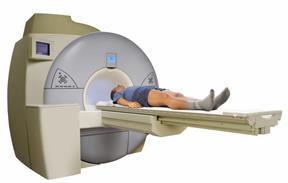MRI (Magnetic Resonance Imaging) Test: What to Expect
An MRI, or magnetic resonance imaging, is a painless test that takes pictures of the inside of your body. It uses a strong magnet. It doesn't use X-rays. An MRI can give more details about a health problem than other tests.
For the MRI, you'll lie on a table that slides into a tunnel. In an open MRI, the tunnel will be open at the sides. In some cases, a dye may be put into your body. This will help make the pictures clearer.
Tell a health care provider about:
-
Any allergies you have.
-
All medicines you take. These include vitamins, herbs, eye drops, and creams.
-
Any surgeries you've had.
-
Any medical conditions you have.
- Any metal you may have in your body. This includes:
Any new joint, such as an artificial knee or hip.
Any implanted devices, such as a pacemaker.
An ear implant with metal called a cochlear implant.
An artificial heart valve.
A metal object in your eye.
Pieces of a bullet.
A port for insulin or chemotherapy.
-
Any tattoos you have.
-
If you have a birth control implant, such as an IUD.
-
Whether you're pregnant or may be pregnant.
-
Whether you're breastfeeding.
-
Any fear of cramped spaces. You may be given a medicine to help you relax.
What are the risks?
Your health care provider will talk with you about risks. These may include:
Not getting clear pictures. This may happen if you have metal in your body near the spot being tested.
An allergic reaction if dye is used.
Damage to your kidneys if dye is used. Drinking lots of water before and after the test can help prevent this.
What happens before the test?
- You'll be asked to take off all metal. This includes:
-
In most cases, braces and fillings aren't a problem.
-
If you're breastfeeding, ask your provider if you need to pump before your test.
What happens during the test?

-
You may be given earplugs or headphones to listen to music. The MRI machine can be loud.
-
You'll lie down on a table.
-
If dye will be used, an IV will be put into a vein in your hand or arm. Dye will be given through the IV.
-
The table will slide into a tunnel. The tunnel has magnets inside of it.
- The tunnel will scan your body and make pictures.
You'll be asked to lie very still.
Your provider will tell you when you can move.
When you're in the tunnel, you'll still be able to talk to your provider.
-
When all the pictures are taken, the table will slide out of the tunnel.
The test can take 30 minutes to over an hour.
These steps may vary. Ask what you can expect.
What can I expect after the test?
-
If you were given a medicine to help you relax, you may be watched closely until you leave. This includes checking your pain level, blood pressure, heart rate, and breathing rate.
- If dye was used:
It'll leave your body through your pee. This takes about a day.
You may be told to drink lots of fluids. This helps your body get rid of the dye.
Do not breastfeed your child unless your provider says it's OK.
Follow these instructions at home:
-
You may go back to your normal activities right away, or as told by your provider.
-
Ask when your test results will be ready and how to get them. You may need to call or meet with your provider to get your results.
-
Talk with your provider about what your results mean. More tests may be needed.
This information is not intended to replace advice given to you by your health care provider. Make sure you discuss any questions you have with your health care provider.
